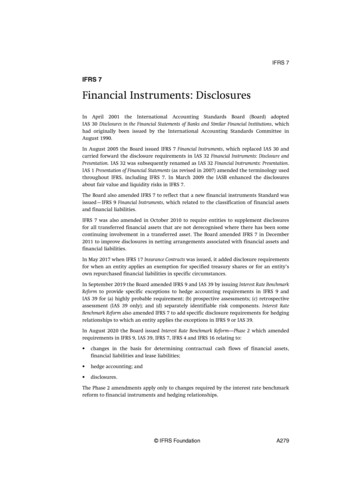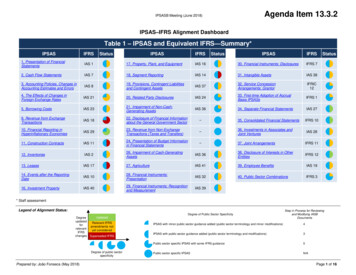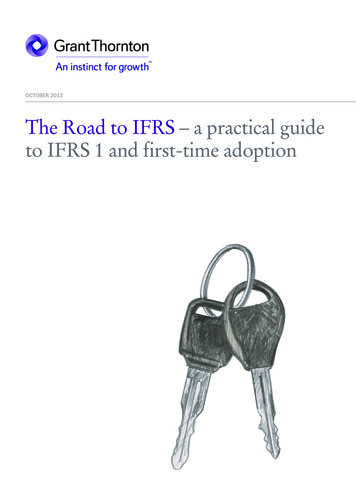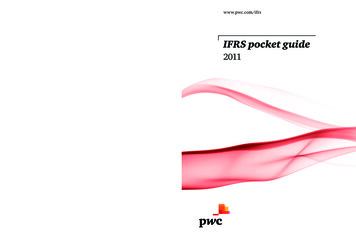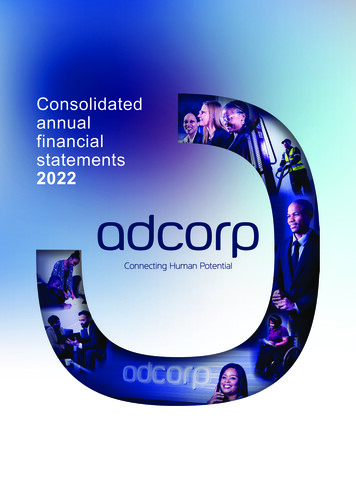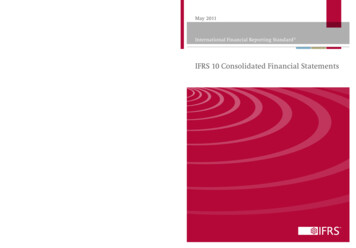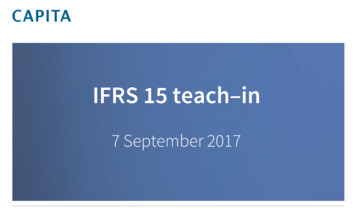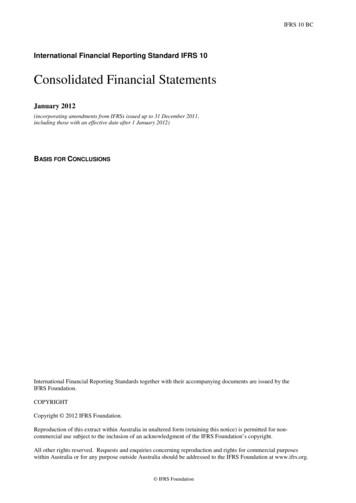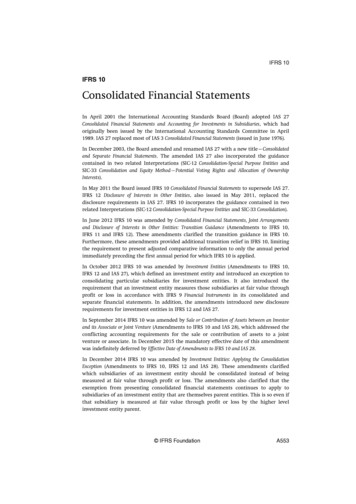
Transcription
IFRS 10IFRS 10Consolidated Financial StatementsIn April 2001 the International Accounting Standards Board (Board) adopted IAS 27Consolidated Financial Statements and Accounting for Investments in Subsidiaries, which hadoriginally been issued by the International Accounting Standards Committee in April1989. IAS 27 replaced most of IAS 3 Consolidated Financial Statements (issued in June 1976).In December 2003, the Board amended and renamed IAS 27 with a new title—Consolidatedand Separate Financial Statements. The amended IAS 27 also incorporated the guidancecontained in two related Interpretations (SIC-12 Consolidation-Special Purpose Entities andSIC-33 Consolidation and Equity Method—Potential Voting Rights and Allocation of OwnershipInterests).In May 2011 the Board issued IFRS 10 Consolidated Financial Statements to supersede IAS 27.IFRS 12 Disclosure of Interests in Other Entities, also issued in May 2011, replaced thedisclosure requirements in IAS 27. IFRS 10 incorporates the guidance contained in tworelated Interpretations (SIC-12 Consolidation-Special Purpose Entities and SIC-33 Consolidation).In June 2012 IFRS 10 was amended by Consolidated Financial Statements, Joint Arrangementsand Disclosure of Interests in Other Entities: Transition Guidance (Amendments to IFRS 10,IFRS 11 and IFRS 12). These amendments clarified the transition guidance in IFRS 10.Furthermore, these amendments provided additional transition relief in IFRS 10, limitingthe requirement to present adjusted comparative information to only the annual periodimmediately preceding the first annual period for which IFRS 10 is applied.In October 2012 IFRS 10 was amended by Investment Entities (Amendments to IFRS 10,IFRS 12 and IAS 27), which defined an investment entity and introduced an exception toconsolidating particular subsidiaries for investment entities. It also introduced therequirement that an investment entity measures those subsidiaries at fair value throughprofit or loss in accordance with IFRS 9 Financial Instruments in its consolidated andseparate financial statements. In addition, the amendments introduced new disclosurerequirements for investment entities in IFRS 12 and IAS 27.In September 2014 IFRS 10 was amended by Sale or Contribution of Assets between an Investorand its Associate or Joint Venture (Amendments to IFRS 10 and IAS 28), which addressed theconflicting accounting requirements for the sale or contribution of assets to a jointventure or associate. In December 2015 the mandatory effective date of this amendmentwas indefinitely deferred by Effective Date of Amendments to IFRS 10 and IAS 28.In December 2014 IFRS 10 was amended by Investment Entities: Applying the ConsolidationException (Amendments to IFRS 10, IFRS 12 and IAS 28). These amendments clarifiedwhich subsidiaries of an investment entity should be consolidated instead of beingmeasured at fair value through profit or loss. The amendments also clarified that theexemption from presenting consolidated financial statements continues to apply tosubsidiaries of an investment entity that are themselves parent entities. This is so even ifthat subsidiary is measured at fair value through profit or loss by the higher levelinvestment entity parent. IFRS FoundationA553
IFRS 10Other Standards have made minor consequential amendments to IFRS 10, includingAnnual Improvements to IFRS Standards 2014–2016 Cycle (issued December 2016) andAmendments to References to the Conceptual Framework in IFRS Standards (issued March 2018).A554 IFRS Foundation
IFRS 10CONTENTSfrom paragraphINTERNATIONAL FINANCIAL REPORTING STANDARD 10CONSOLIDATED FINANCIAL STATEMENTSOBJECTIVE1Meeting the objective2SCOPE4CONTROL5Power10Returns15Link between power and returns17ACCOUNTING REQUIREMENTS19Non-controlling interests22Loss of control25DETERMINING WHETHER AN ENTITY IS AN INVESTMENT ENTITY27INVESTMENT ENTITIES: EXCEPTION TO CONSOLIDATION31APPENDICESA Defined termsB Application guidanceC Effective date and transitionD Amendments to other IFRSsAPPROVAL BY THE BOARD OF IFRS 10 ISSUED IN MAY 2011APPROVAL BY THE BOARD OF AMENDMENTS TO IFRS 10:Consolidated Financial Statements, Joint Arrangements and Disclosure ofInterests in other Entities: Transition Guidance (Amendments to IFRS 10,IFRS 11 and IFRS 12) issued in June 2012Investment Entities (Amendments to IFRS 10, IFRS 12 and IAS 27) issued inOctober 2012Sale or Contribution of Assets between an Investor and its Associate orJoint Venture (Amendments to IFRS 10 and IAS 28) issued in September2014Investment Entities: Applying the Consolidation Exception (Amendments toIFRS 10, IFRS 12 and IAS 28) issued in December 2014Effective Date of Amendments to IFRS 10 and IAS 28 issued inDecember 2015FOR THE ACCOMPANYING GUIDANCE LISTED BELOW, SEE PART B OF THIS EDITIONILLUSTRATIVE EXAMPLESAMENDMENTS TO THE GUIDANCE ON OTHER IFRSSFOR THE BASIS FOR CONCLUSIONS, SEE PART C OF THIS EDITIONcontinued. IFRS FoundationA555
IFRS 10.continuedBASIS FOR CONCLUSIONSAPPENDICES TO THE BASIS FOR CONCLUSIONSPrevious Board approvals and dissenting opinionsAmendments to the Basis for Conclusions on other IFRSsA556 IFRS Foundation
IFRS 10International Financial Reporting Standard 10 Consolidated Financial Statements (IFRS 10)is set out in paragraphs 1–33 and Appendices A–D. All the paragraphs have equalauthority. Paragraphs in bold type state the main principles. Terms definedin Appendix A are in italics the first time they appear in the Standard. Definitions ofother terms are given in the Glossary for International Financial Reporting Standards.IFRS 10 should be read in the context of its objective and the Basis for Conclusions,the Preface to IFRS Standards and the Conceptual Framework for FinancialReporting. IAS 8 Accounting Policies, Changes in Accounting Estimates and Errors provides abasis for selecting and applying accounting policies in the absence of explicit guidance. IFRS FoundationA557
IFRS 10International Financial Reporting Standard 10Consolidated Financial StatementsObjective1The objective of this IFRS is to establish principles for the presentation andpreparation of consolidated financial statements when an entity controls oneor more other entities.Meeting the objective23To meet the objective in paragraph 1, this IFRS:(a)requires an entity (the parent) that controls one or more other entities(subsidiaries) to present consolidated financial statements;(b)defines the principle of control, and establishes control as the basis forconsolidation;(c)sets out how to apply the principle of control to identify whether aninvestor controls an investee and therefore must consolidate theinvestee;(d)sets out the accounting requirements for the preparation ofconsolidated financial statements; and(e)defines an investment entity and sets out an exception to consolidatingparticular subsidiaries of an investment entity.This IFRS does not deal with the accounting requirements for businesscombinations and their effect on consolidation, including goodwill arising ona business combination (see IFRS 3 Business Combinations).Scope4An entity that is a parent shall present consolidated financial statements. ThisIFRS applies to all entities, except as follows:(a)A558a parent need not present consolidated financial statements if it meetsall the following conditions:(i)it is a wholly-owned subsidiary or is a partially-ownedsubsidiary of another entity and all its other owners, includingthose not otherwise entitled to vote, have been informed about,and do not object to, the parent not presenting consolidatedfinancial statements;(ii)its debt or equity instruments are not traded in a public market(a domestic or foreign stock exchange or an over-the-countermarket, including local and regional markets); IFRS Foundation
IFRS 10(iii)it did not file, nor is it in the process of filing, its financialstatements with a securities commission or other regulatoryorganisation for the purpose of issuing any class of instrumentsin a public market; and(iv)its ultimate or any intermediate parent produces financialstatements that are available for public use and comply withIFRSs, in which subsidiaries are consolidated or are measured atfair value through profit or loss in accordance with this IFRS.(b)[deleted](c)[deleted]4AThis IFRS does not apply to post-employment benefit plans or other long-termemployee benefit plans to which IAS 19 Employee Benefits applies.4BA parent that is an investment entity shall not present consolidated financialstatements if it is required, in accordance with paragraph 31 of this IFRS, tomeasure all of its subsidiaries at fair value through profit or loss.Control5An investor, regardless of the nature of its involvement with an entity (theinvestee), shall determine whether it is a parent by assessing whether itcontrols the investee.6An investor controls an investee when it is exposed, or has rights, tovariable returns from its involvement with the investee and has the abilityto affect those returns through its power over the investee.7Thus, an investor controls an investee if and only if the investor has all thefollowing:(a)power over the investee (see paragraphs 10–14);(b)exposure, or rights, to variable returns from its involvement withthe investee (see paragraphs 15 and 16); and(c)the ability to use its power over the investee to affect the amount ofthe investor’s returns (see paragraphs 17 and 18).8An investor shall consider all facts and circumstances when assessing whetherit controls an investee. The investor shall reassess whether it controls aninvestee if facts and circumstances indicate that there are changes to one ormore of the three elements of control listed in paragraph 7 (see paragraphsB80–B85).9Two or more investors collectively control an investee when they must acttogether to direct the relevant activities. In such cases, because no investorcan direct the activities without the co-operation of the others, no investorindividually controls the investee. Each investor would account for its interestin the investee in accordance with the relevant IFRSs, such as IFRS 11 JointArrangements, IAS 28 Investments in Associates and Joint Ventures or IFRS 9 FinancialInstruments. IFRS FoundationA559
IFRS 10Power10An investor has power over an investee when the investor has existing rightsthat give it the current ability to direct the relevant activities, ie the activitiesthat significantly affect the investee’s returns.11Power arises from rights. Sometimes assessing power is straightforward, suchas when power over an investee is obtained directly and solely from the votingrights granted by equity instruments such as shares, and can be assessed byconsidering the voting rights from those shareholdings. In other cases, theassessment will be more complex and require more than one factor to beconsidered, for example when power results from one or more contractualarrangements.12An investor with the current ability to direct the relevant activities has powereven if its rights to direct have yet to be exercised. Evidence that the investorhas been directing relevant activities can help determine whether the investorhas power, but such evidence is not, in itself, conclusive in determiningwhether the investor has power over an investee.13If two or more investors each have existing rights that give them theunilateral ability to direct different relevant activities, the investor that hasthe current ability to direct the activities that most significantly affect thereturns of the investee has power over the investee.14An investor can have power over an investee even if other entities haveexisting rights that give them the current ability to participate in the directionof the relevant activities, for example when another entity has significantinfluence. However, an investor that holds only protective rights does not havepower over an investee (see paragraphs B26–B28), and consequently does notcontrol the investee.Returns15An investor is exposed, or has rights, to variable returns from its involvementwith the investee when the investor’s returns from its involvement have thepotential to vary as a result of the investee’s performance. The investor’sreturns can be only positive, only negative or both positive and negative.16Although only one investor can control an investee, more than one party canshare in the returns of an investee. For example, holders of non-controllinginterests can share in the profits or distributions of an investee.Link between power and returns17A560An investor controls an investee if the investor not only has power over theinvestee and exposure or rights to variable returns from its involvement withthe investee, but also has the ability to use its power to affect the investor’sreturns from its involvement with the investee. IFRS Foundation
IFRS 1018Thus, an investor with decision-making rights shall determine whether it is aprincipal or an agent. An investor that is an agent in accordance withparagraphs B58–B72 does not control an investee when it exercises decisionmaking rights delegated to it.Accounting requirements19A parent shall prepare consolidated financial statements using uniformaccounting policies for like transactions and other events in similarcircumstances.20Consolidation of an investee shall begin from the date the investor obtainscontrol of the investee and cease when the investor loses control of theinvestee.21Paragraphs B86–B93 set out guidance for the preparation of consolidatedfinancial statements.Non-controlling interests22A parent shall present non-controlling interests in the consolidated statementof financial position within equity, separately from the equity of the owners ofthe parent.23Changes in a parent’s ownership interest in a subsidiary that do not result inthe parent losing control of the subsidiary are equity transactions (ietransactions with owners in their capacity as owners).24Paragraphs B94–B96 set out guidance for the accounting for non-controllinginterests in consolidated financial statements.Loss of control2526If a parent loses control of a subsidiary, the parent:(a)derecognises the assets and liabilities of the former subsidiary from theconsolidated statement of financial position.(b)recognises any investment retained in the former subsidiary andsubsequently accounts for it and for any amounts owed by or to theformer subsidiary in accordance with relevant IFRSs. That retainedinterest is remeasured, as described in paragraphs B98(b)(iii) and B99A.The remeasured value at the date that control is lost shall be regardedas the fair value on initial recognition of a financial asset in accordancewith IFRS 9 or the cost on initial recognition of an investment in anassociate or joint venture, if applicable.(c)recognises the gain or loss associated with the loss of controlattributable to the former controlling interest, as specified inparagraphs B98–B99A.Paragraphs B97–B99A set out guidance for the accounting for the loss ofcontrol of a subsidiary. IFRS FoundationA561
IFRS 10Determining whether an entity is an investment entity27A parent shall determine whether it is an investment entity. An investmententity is an entity that:(a)obtains funds from one or more investors for the purpose ofproviding those investor(s) with investment management services;(b)commits to its investor(s) that its business purpose is to invest fundssolely for returns from capital appreciation, investment income, orboth; and(c)measures and evaluates the performance of substantially all of itsinvestments on a fair value basis.Paragraphs B85A–B85M provide related application guidance.28In assessing whether it meets the definition described in paragraph 27, anentity shall consider whether it has the following typical characteristics of aninvestment entity:(a)it has more than one investment (see paragraphs B85O–B85P);(b)it has more than one investor (see paragraphs B85Q–B85S);(c)it has investors that are not related parties of the entity(see paragraphs B85T–B85U); and(d)it has ownership interests in the form of equity or similar interests(see paragraphs B85V–B85W).The absence of any of these typical characteristics does not necessarilydisqualify an entity from being classified as an investment entity. Aninvestment entity that does not have all of these typical characteristicsprovides additional disclosure required by paragraph 9A of IFRS 12 Disclosure ofInterests in Other Entities.29If facts and circumstances indicate that there are changes to one or more ofthe three elements that make up the definition of an investment entity, asdescribed in paragraph 27, or the typical characteristics of an investmententity, as described in paragraph 28, a parent shall reassess whether it is aninvestment entity.30A parent that either ceases to be an investment entity or becomes aninvestment entity shall account for the change in its status prospectively fromthe date at which the change in status occurred (see paragraphs B100–B101).A562 IFRS Foundation
IFRS 10Investment entities: exception to consolidation31Except as described in paragraph 32, an investment entity shall notconsolidate its subsidiaries or apply IFRS 3 when it obtains control ofanother entity. Instead, an investment entity shall measure an investmentin a subsidiary at fair value through profit or loss in accordancewith IFRS 9.132Notwithstanding the requirement in paragraph 31, if an investment entity hasa subsidiary that is not itself an investment entity and whose main purposeand activities are providing services that relate to the investment entity’sinvestment activities (see paragraphs B85C–B85E), it shall consolidate thatsubsidiary in accordance with paragraphs 19–26 of this IFRS and apply therequirements of IFRS 3 to the acquisition of any such subsidiary.33A parent of an investment entity shall consolidate all entities that it controls,including those controlled through an investment entity subsidiary, unlessthe parent itself is an investment entity.1Paragraph C7 of IFRS 10 Consolidated Financial Statements states “If an entity applies this IFRS butdoes not yet apply IFRS 9, any reference in this IFRS to IFRS 9 shall be read as a reference toIAS 39 Financial Instruments: Recognition and Measurement.” IFRS FoundationA563
IFRS 10Appendix ADefined termsThis appendix is an integral part of the IFRS.consolidated financialstatementsThe financial statements of a group in which the assets,liabilities, equity, income, expenses and cash flows ofthe parent and its subsidiaries are presented as those of asingle economic entity.control of an investeeAn investor controls an investee when the investor is exposed,or has rights, to variable returns from its involvement with theinvestee and has the ability to affect those returns throughits power over the investee.decision makerAn entity with decision-making rights that is either a principalor an agent for other parties.groupA parent and its subsidiaries.investment entityAn entity that:(a)obtains funds from one or more investors for thepurpose of providing those investor(s) with investmentmanagement services;(b)commits to its investor(s) that its business purpose is toinvest funds solely for returns from capital appreciation,investment income, or both; and(c)measures and evaluates the performance ofsubstantially all of its investments on a fair value basis.non-controllinginterestEquity in a subsidiary not attributable, directly or indirectly, toa parent.parentAn entity that controls one or more entities.powerExisting rights that give the current ability to directthe relevant activities.protective rightsRights designed to protect the interest of the party holdingthose rights without giving that party power over the entity towhich those rights relate.relevant activitiesFor the purpose of this IFRS, relevant activities are activities ofthe investee that significantly affect the investee’s returns.removal rightsRights to deprive the decision maker of its decisionmaking authority.subsidiaryAn entity that is controlled by another entity.A564 IFRS Foundation
IFRS 10The following terms are defined in IFRS 11, IFRS 12 Disclosure of Interests in OtherEntities, IAS 28 (as amended in 2011) or IAS 24 Related Party Disclosures and are used in thisIFRS with the meanings specified in those IFRSs: associate interest in another entity joint venture key management personnel related party significant influence. IFRS FoundationA565
IFRS 10Appendix BApplication guidanceThis appendix is an integral part of the IFRS. It describes the application of paragraphs 1–33 and hasthe same authority as the other parts of the IFRS.B1The examples in this appendix portray hypothetical situations. Although someaspects of the examples may be present in actual fact patterns, all facts andcircumstances of a particular fact pattern would need to be evaluated whenapplying IFRS 10.Assessing controlB2B3B4To determine whether it controls an investee an investor shall assess whetherit has all the following:(a)power over the investee;(b)exposure, or rights, to variable returns from its involvement with theinvestee; and(c)the ability to use its power over the investee to affect the amount ofthe investor’s returns.Consideration of the following factors may assist in making thatdetermination:(a)the purpose and design of the investee (see paragraphs B5–B8);(b)what the relevant activities are and how decisions about thoseactivities are made (see paragraphs B11–B13);(c)whether the rights of the investor give it the current ability to directthe relevant activities (see paragraphs B14–B54);(d)whether the investor is exposed, or has rights, to variable returns fromits involvement with the investee (see paragraphs B55–B57); and(e)whether the investor has the ability to use its power over the investeeto affect the amount of the investor’s returns (see paragraphsB58–B72).When assessing control of an investee, an investor shall consider the nature ofits relationship with other parties (see paragraphs B73–B75).Purpose and design of an investeeB5A566When assessing control of an investee, an investor shall consider the purposeand design of the investee in order to identify the relevant activities, howdecisions about the relevant activities are made, who has the current ability todirect those activities and who receives returns from those activities. IFRS Foundation
IFRS 10B6When an investee’s purpose and design are considered, it may be clear that aninvestee is controlled by means of equity instruments that give the holderproportionate voting rights, such as ordinary shares in the investee. In thiscase, in the absence of any additional arrangements that alter decisionmaking, the assessment of control focuses on which party, if any, is able toexercise voting rights sufficient to determine the investee’s operating andfinancing policies (see paragraphs B34–B50). In the most straightforward case,the investor that holds a majority of those voting rights, in the absence of anyother factors, controls the investee.B7To determine whether an investor controls an investee in more complex cases,it may be necessary to consider some or all of the other factors inparagraph B3.B8An investee may be designed so that voting rights are not the dominant factorin deciding who controls the investee, such as when any voting rights relate toadministrative tasks only and the relevant activities are directed by means ofcontractual arrangements. In such cases, an investor’s consideration of thepurpose and design of the investee shall also include consideration of the risksto which the investee was designed to be exposed, the risks it was designed topass on to the parties involved with the investee and whether the investor isexposed to some or all of those risks. Consideration of the risks includes notonly the downside risk, but also the potential for upside.PowerB9To have power over an investee, an investor must have existing rights thatgive it the current ability to direct the relevant activities. For the purpose ofassessing power, only substantive rights and rights that are not protectiveshall be considered (see paragraphs B22–B28).B10The determination about whether an investor has power depends on therelevant activities, the way decisions about the relevant activities are madeand the rights the investor and other parties have in relation to the investee.Relevant activities and direction of relevant activitiesB11B12For many investees, a range of operating and financing activities significantlyaffect their returns. Examples of activities that, depending on thecircumstances, can be relevant activities include, but are not limited to:(a)selling and purchasing of goods or services;(b)managing financial assets during their life (including upon default);(c)selecting, acquiring or disposing of assets;(d)researching and developing new products or processes; and(e)determining a funding structure or obtaining funding.Examples of decisions about relevant activities include but are not limited to:(a)establishing operating and capital decisions of the investee, includingbudgets; and IFRS FoundationA567
IFRS 10(b)B13appointing and remunerating an investee’s key management personnelor service providers and terminating their services or employment.In some situations, activities both before and after a particular set ofcircumstances arises or event occurs may be relevant activities. When two ormore investors have the current ability to direct relevant activities and thoseactivities occur at different times, the investors shall determine whichinvestor is able to direct the activities that most significantly affect thosereturns consistently with the treatment of concurrent decision-making rights(see paragraph 13). The investors shall reconsider this assessment over time ifrelevant facts or circumstances change.Application examplesExample 1Two investors form an investee to develop and market a medical product.One investor is responsible for developing and obtaining regulatory approvalof the medical product—that responsibility includes having the unilateralability to make all decisions relating to the development of the product andto obtaining regulatory approval. Once the regulator has approved theproduct, the other investor will manufacture and market it—this investorhas the unilateral ability to make all decisions about the manufacture andmarketing of the product. If all the activities—developing and obtainingregulatory approval as well as manufacturing and marketing of the medicalproduct—are relevant activities, each investor needs to determine whether itis able to direct the activities that most significantly affect the investee’sreturns. Accordingly, each investor needs to consider whether developingand obtaining regulatory approval or the manufacturing and marketing ofthe medical product is the activity that most significantly affects theinvestee’s returns and whether it is able to direct that activity. Indetermining which investor has power, the investors would consider:(a)the purpose and design of the investee;(b)the factors that determine the profit margin, revenue and value ofthe investee as well as the value of the medical product;(c)the effect on the investee’s returns resulting from each investor’sdecision-making authority with respect to the factors in (b); and(d)the investors’ exposure to variability of returns.In this particular example, the investors would also consider:(e)the uncertainty of, and effort required in, obtaining regulatoryapproval (considering the investor’s record of successfully developingand obtaining regulatory approval of medical products); and(f)which investor controls the medical product once the developmentphase is successful.continued.A568 IFRS Foundation
IFRS 10.continuedApplication examplesExample 2An investment vehicle (the investee) is created and financed with a debtinstrument held by an investor (the debt investor) and equity instrumentsheld by a number of other investors. The equity tranche is designed toabsorb the first losses and to receive any residual return from the investee.One of the equity investors who holds 30 per cent of the equity is also theasset manager. The investee uses its proceeds to purchase a portfolio offinancial assets, exposing the investee to the credit risk associated with thepossible default of principal and interest payments of the assets. Thetransaction is marketed to the debt investor as an investment with minimalexposure to the credit risk associated with the possible default of the assetsin the portfolio because of the nature of these assets and because the equitytranche is designed to absorb the first losses of the investee. The returns ofthe investee are significantly affected by the management of the investee’sasset portfolio, which includes decisions about the selection, acquisition anddisposal of the assets within portfolio guidelines and the management upondefault of any portfolio assets. All those activities are managed by the assetmanager until defaults reach a specified proportion of the portfolio value(ie when the value of the portfolio is such that the equity tranche of theinvestee has been consumed). From that time, a third-party trustee managesthe assets according to the instructions of the debt investor. Managing theinvestee’s asset portfolio is the relevant activity of the investee. The assetmanager has the ability to direct the relevant activities until defaulted assetsreach the specified proportion of the portfolio value; the debt investor hasthe ability to direct the relevant activities when the value of defaulted assetssurpasses that specified proportion of the portfolio value. The asset managerand the debt investor each need to determine whether they are able to directthe activities that most significantly affect the investee’s returns, includingconsidering the purpose and design of the investee as well as each party’sex
Consolidated Financial Statements and Accounting for Investments in Subsidiaries, which had originally been issued by the International Accounting Standards Committee in April 1989. IAS 27 replaced most of IAS 3 Consolidated Financial Statements (issued in June 1976). In December 2003, the Board amended and renamed IAS 27 with a new title .
